A Model-Based Climatology of Low-Level Jets in the Weddell Sea Region of the Antarctic
Abstract
1. Introduction
2. Materials and Methods
2.1. The CCLM Model
2.2. Low-Level Jet Detection
2.3. Boundary Layer and Inversion Height
3. Results
3.1. Case Studies of LLJs
3.1.1. LLJ over the Sea Ice on 1 July 2016
3.1.2. Katabatic LLJ over Coats Land on 10 June 2014
3.2. Wind Climatology of the ABL
3.3. Low-Level Jet Statistics
3.3.1. Comparison to Radiosonde Data
3.3.2. Climatology from Model Simulations
4. Discussion
Supplementary Materials
Author Contributions
Funding
Institutional Review Board Statement
Informed Consent Statement
Data Availability Statement
Acknowledgments
Conflicts of Interest
References
- Gorodetskaya, I.V.; Tsukernik, M.; Claes, K.; Ralph, M.F.; Neff, W.D.; van Lipzig, N.P.M. The role of atmospheric rivers in anomalous snow accumulation in East Antarctica. Geophys. Res. Lett. 2014, 41, 6199–6206. [Google Scholar] [CrossRef]
- Zentek, R.; Kohnemann, S.H.E.; Heinemann, G. Analysis of the performance of a ship-borne scanning wind lidar in the Arctic and Antarctic. Atmos. Meas. Tech. 2018, 11, 5781–5795. [Google Scholar] [CrossRef]
- Guest, P.; Persson, P.O.G.; Wang, S.; Jordan, M.; Jin, Y.; Blomquist, B.; Fairall, C. Low-Level Baroclinic Jets Over the New Arctic Ocean. J. Geophys. Res. Oceans 2018, 123, 4074–4091. [Google Scholar] [CrossRef]
- Jakobson, L.; Vihma, T.; Jakobson, E.; Palo, T.; Männik, A.; Jaagus, J. Low-level jet characteristics over the Arctic Ocean in spring and summer. Atmos. Chem. Phys. 2013, 13, 11089–11099. [Google Scholar] [CrossRef]
- Heinemann, G.; Drüe, C.; Schwarz, P.; Makshtas, A. Observations of Wintertime Low-Level Jets in the Coastal Region of the Laptev Sea in the Siberian Arctic Using SODAR/RASS. Remote Sens. 2021, 13, 1421. [Google Scholar] [CrossRef]
- Andreas, E.L.; Claffy, K.J.; Makshtas, A.P. Low-Level Atmospheric Jets and Inversions over the Western Weddell Sea. Bound.-Layer Meteorol. 2000, 97, 459–486. [Google Scholar] [CrossRef]
- Heinemann, G.; Rose, L. Surface energy balance, parameterizations of boundary-layer heights and the application of resistance laws near an Antarctic Ice Shelf front. Bound.-Layer Meteorol. 1990, 51, 123–158. [Google Scholar] [CrossRef]
- Heinemann, G. Aircraft-Based Measurements Of Turbulence Structures In The Katabatic Flow Over Greenland. Bound.-Layer Meteorol. 2002, 103, 49–81. [Google Scholar] [CrossRef]
- Heinemann, G. The KABEG’97 field experiment: An aircraft-based study of katabatic wind dynamics over the Greenland ice sheet. Bound.-Layer Meteorol. 1999, 93, 75–116. [Google Scholar] [CrossRef]
- Renfrew, I.A.; Anderson, P.S. Profiles of katabatic flow in summer and winter over Coats Land, Antarctica. Q. J. R. Meteorol. Soc. 2006, 132, 779–802. [Google Scholar] [CrossRef]
- Wendler, G. Strong gravity flow observed along the slope of Eastern Antarctica. Meteorl. Atmos. Phys. 1990, 43, 127–135. [Google Scholar] [CrossRef]
- Loewe, F. The land of storms. Weather 1972, 27, 110–121. [Google Scholar] [CrossRef]
- Kodama, Y.; Wendler, G.; Ishikawa, N. The Diurnal Variation of the Boundary Layer in Summer in Adelie Land, Eastern Antarctica. J. Appl. Meteor. 1989, 28, 16–24. [Google Scholar] [CrossRef]
- Gallée, H.; Barral, H.; Vignon, E.; Genthon, C. A case study of a low-level jet during OPALE. Atmos. Chem. Phys. 2015, 15, 6237–6246. [Google Scholar] [CrossRef]
- Vignon, É.; Traullé, O.; Berne, A. On the fine vertical structure of the low troposphere over the coastal margins of East Antarctica. Atmos. Chem. Phys. 2019, 19, 4659–4683. [Google Scholar] [CrossRef]
- Schwerdtfeger, W. Meteorological aspects of the drift of ice from the Weddell Sea toward the mid-latitude westerlies. J. Geophys. Res. 1979, 84, 6321. [Google Scholar] [CrossRef]
- Nigro, M.A.; Cassano, J.J.; Lazzara, M.A.; Keller, L.M. Case Study of a Barrier Wind Corner Jet off the Coast of the Prince Olav Mountains, Antarctica. Mon. Weather Rev. 2012, 140, 2044–2063. [Google Scholar] [CrossRef]
- O’Connor, W.P.; Bromwich, D.H.; Carrasco, J.F. Cyclonically Forced Barrier Winds along the Transantarctic Mountains near Ross Island. Mon. Weather Rev. 1994, 122, 137–150. [Google Scholar] [CrossRef]
- Elvidge, A.D.; Renfrew, I.A.; King, J.C.; Orr, A.; Lachlan-Cope, T.A.; Weeks, M.; Gray, S.L. Foehn jets over the Larsen C Ice Shelf, Antarctica. Q. J. R. Meteorol. Soc. 2015, 141, 698–713. [Google Scholar] [CrossRef]
- Orr, A.; Kirchgaessner, A.; King, J.; Phillips, T.; Gilbert, E.; Elvidge, A.; Weeks, M.; Gadian, A.; Kuipers Munneke, P.; Broeke, M.; et al. Comparison of kilometre and sub-kilometre scale simulations of a foehn wind event over the Larsen C Ice Shelf, Antarctic Peninsula using the Met Office Unified Model (MetUM). Q. J. R. Meteorol. Soc. 2021, 147, 3472–3492. [Google Scholar] [CrossRef]
- KING, J.C.; Lachlan-Cope, T.A.; Ladkin, R.S.; Weiss, A. Airborne Measurements in the Stable Boundary Layer over the Larsen Ice Shelf, Antarctica. Bound.-Layer Meteorol. 2008, 127, 413–428. [Google Scholar] [CrossRef][Green Version]
- Seefeldt, M.W.; Cassano, J.J. An Analysis of Low-Level Jets in the Greater Ross Ice Shelf Region Based on Numerical Simulations. Mon. Weather Rev. 2008, 136, 4188–4205. [Google Scholar] [CrossRef]
- Parish, T.R.; Bromwich, D.H. Reexamination of the Near-Surface Airflow over the Antarctic Continent and Implications on Atmospheric Circulations at High Southern Latitudes. Mon. Weather Rev. 2007, 135, 1961–1973. [Google Scholar] [CrossRef]
- Ebner, L.; Heinemann, G.; Haid, V.; Timmermann, R. Katabatic winds and polynya dynamics at Coats Land, Antarctica. Antarct. Sci. 2014, 26, 309–326. [Google Scholar] [CrossRef]
- Tastula, E.-M.; Vihma, T.; Andreas, E.L. Evaluation of Polar WRF from Modeling the Atmospheric Boundary Layer over Antarctic Sea Ice in Autumn and Winter. Mon. Weather Rev. 2012, 140, 3919–3935. [Google Scholar] [CrossRef]
- Van Lipzig, N.P.M.; Turner, J.; Colwell, S.R.; van den Broeke, M.R. The near-surface wind field over the Antarctic continent. Int. J. Climatol. 2004, 24, 1973–1982. [Google Scholar] [CrossRef]
- Souverijns, N.; Gossart, A.; Demuzere, M.; Lenaerts, J.T.M.; Medley, B.; Gorodetskaya, I.V.; Vanden Broucke, S.; van Lipzig, N.P.M. A New Regional Climate Model for POLAR-CORDEX: Evaluation of a 30-Year Hindcast with COSMO-CLM 2 over Antarctica. J. Geophys. Res. 2019, 124, 1405–1427. [Google Scholar] [CrossRef]
- Van Wessem, J.M.; van de Berg, W.J.; Noël, B.P.Y.; van Meijgaard, E.; Amory, C.; Birnbaum, G.; Jakobs, C.L.; Krüger, K.; Lenaerts, J.T.M.; Lhermitte, S.; et al. Modelling the climate and surface mass balance of polar ice sheets using RACMO2—Part 2: Antarctica (1979–2016). Cryosphere 2018, 12, 1479–1498. [Google Scholar] [CrossRef]
- Lenaerts, J.T.M.; Vizcaino, M.; Fyke, J.; van Kampenhout, L.; van den Broeke, M.R. Present-day and future Antarctic ice sheet climate and surface mass balance in the Community Earth System Model. Clim. Dyn. 2016, 47, 1367–1381. [Google Scholar] [CrossRef]
- Van de Berg, W.J.; van den Broeke, M.R.; van Meijgaard, E. Heat budget of the East Antarctic lower atmosphere derived from a regional atmospheric climate model. J. Geophys. Res. 2007, 112. [Google Scholar] [CrossRef]
- Zentek, R.; Heinemann, G. Verification of the regional atmospheric model CCLM v5.0 with conventional data and lidar measurements in Antarctica. Geosci. Model Dev. 2020, 13, 1809–1825. [Google Scholar] [CrossRef]
- Kohnemann, S.H.E.; Heinemann, G.; Bromwich, D.H.; Gutjahr, O. Extreme Warming in the Kara Sea and Barents Sea during the Winter Period 2000–16. J. Clim. 2017, 30, 8913–8927. [Google Scholar] [CrossRef]
- Kohnemann, S.H.; Heinemann, G. A climatology of wintertime low-level jets in Nares Strait. POLAR 2021, 40. [Google Scholar] [CrossRef]
- Heinemann, G. Assessment of Regional Climate Model Simulations of the Katabatic Boundary Layer Structure over Greenland. Atmosphere 2020, 11, 571. [Google Scholar] [CrossRef]
- Gutjahr, O.; Heinemann, G.; Preußer, A.; Willmes, S.; Drüe, C. Quantification of ice production in Laptev Sea polynyas and its sensitivity to thin-ice parameterizations in a regional climate model. Cryosphere 2016, 10, 2999–3019. [Google Scholar] [CrossRef]
- Dee, D.P.; Uppala, S.M.; Simmons, A.J.; Berrisford, P.; Poli, P.; Kobayashi, S.; Andrae, U.; Balmaseda, M.A.; Balsamo, G.; Bauer, P.; et al. The ERA-Interim reanalysis: Configuration and performance of the data assimilation system. Q. J. R. Meteorol. Soc. 2011, 137, 553–597. [Google Scholar] [CrossRef]
- Schröder, D.; Heinemann, G.; Willmes, S. The impact of a thermodynamic sea-ice module in the COSMO numerical weather prediction model on simulations for the Laptev Sea, Siberian Arctic. Polar Res. 2011, 30, 6334. [Google Scholar] [CrossRef]
- Spreen, G.; Kaleschke, L.; Heygster, G. Sea ice remote sensing using AMSR-E 89-GHz channels. J. Geophys. Res. 2008, 113, 14485. [Google Scholar] [CrossRef]
- Kurtz, N.T.; Markus, T. Satellite observations of Antarctic sea ice thickness and volume. J. Geophys. Res. 2012, 117. [Google Scholar] [CrossRef]
- Schaffer, J.; Timmermann, R.; Arndt, J.E.; Kristensen, S.S.; Mayer, C.; Morlighem, M.; Steinhage, D. A global, high-resolution data set of ice sheet topography, cavity geometry, and ocean bathymetry. Earth Syst. Sci. Data 2016, 8, 543–557. [Google Scholar] [CrossRef]
- Doms, G.; Förstner, J.; Heise, H.; Herzog, H.-J.; Mironov, D.; Raschendorfer, M.; Reinhardt, T.; Ritter, B.; Schrodin, R.; Schulz, J.-P.; et al. A Description of the Nonhydrostatic Regional COSMO-Model. Part II. Physical Parameterizations; Deutscher Wetterdienst: Offenbach, Germany, 2013. [Google Scholar]
- Lott, F.; Miller, M.J. A new subgrid-scale orographic drag parametrization: Its formulation and testing. Q. J. R. Meteorol. Soc. 1997, 123, 101–127. [Google Scholar] [CrossRef]
- Zentek, R. COSMO Documentation (Archived Version from 2019, Uploaded with Permission of the DWD). 2019. Available online: https://zenodo.org/record/3339384 (accessed on 7 May 2021).
- Tuononen, M.; Sinclair, V.A.; Vihma, T. A climatology of low-level jets in the mid-latitudes and polar regions of the Northern Hemisphere. Atmos. Sci. Lett. 2015, 16, 492–499. [Google Scholar] [CrossRef]
- Wetzel, P.J. Toward Parameterization of the Stable Boundary Layer. J. Appl. Meteor. 1982, 21, 7–13. [Google Scholar] [CrossRef]
- Vogelezang, D.H.P.; Holtslag, A.A.M. Evaluation and model impacts of alternative boundary-layer height formulations. Bound.-Layer Meteorol. 1996, 81, 245–269. [Google Scholar] [CrossRef]
- Heinemann, G. An Aircraft-Based Study of Strong Gap Flows in Nares Strait, Greenland. Mon. Weather Rev. 2018, 146, 3589–3604. [Google Scholar] [CrossRef]
- Heinemann, G.; Klein, T. Modelling and observations of the katabatic flow dynamics over Greenland. Tellus A 2002, 54, 542–554. [Google Scholar] [CrossRef]
- Dirksen, R.J.; Sommer, M.; Immler, F.J.; Hurst, D.F.; Kivi, R.; Vömel, H. Reference quality upper-air measurements: GRUAN data processing for the Vaisala RS92 radiosonde. Atmos. Meas. Tech. 2014, 7, 4463–4490. [Google Scholar] [CrossRef]
- Heinemann, G. Mesoscale Vortices in the Weddell Sea Region (Antarctica). Mon. Weather Rev. 1990, 118, 779–793. [Google Scholar] [CrossRef][Green Version]
- Tsiringakis, A.; Steeneveld, G.J.; Holtslag, A.A.M. Small-scale orographic gravity wave drag in stable boundary layers and its impact on synoptic systems and near-surface meteorology. Q. J. R. Meteorol. Soc. 2017, 143, 1504–1516. [Google Scholar] [CrossRef]
- Parish, T.R.; Bromwich, D.H. Continental-Scale Simulation of the Antarctic Katabatic Wind Regime. J. Clim. 1991, 4, 135–146. [Google Scholar] [CrossRef]
- Van Wessem, J.M.; Reijmer, C.H.; van de Berg, W.J.; van den Broeke, M.R.; Cook, A.J.; van Ulft, L.H.; van Meijgaard, E. Temperature and Wind Climate of the Antarctic Peninsula as Simulated by a High-Resolution Regional Atmospheric Climate Model. J. Clim. 2015, 28, 7306–7326. [Google Scholar] [CrossRef]
- Baas, P.; Bosveld, F.C.; Klein Baltink, H.; Holtslag, A.A.M. A Climatology of Nocturnal Low-Level Jets at Cabauw. J. Appl. Meteor. Climatol. 2009, 48, 1627–1642. [Google Scholar] [CrossRef]
- Karipot, A.; Leclerc, M.Y.; Zhang, G. Characteristics of Nocturnal Low-Level Jets Observed in the North Florida Area. Mon. Weather Rev. 2009, 137, 2605–2621. [Google Scholar] [CrossRef]
- Elvidge, A.D.; Renfrew, I.A.; King, J.C.; Orr, A.; Lachlan-Cope, T.A. Foehn warming distributions in nonlinear and linear flow regimes: A focus on the Antarctic Peninsula. Q. J. R. Meteorol. Soc. 2016, 142, 618–631. [Google Scholar] [CrossRef]
- Turton, J.V.; Kirchgaessner, A.; Ross, A.N.; King, J.C. Does high-resolution modelling improve the spatial analysis of föhn flow over the Larsen C Ice Shelf? Weather 2017, 72, 192–196. [Google Scholar] [CrossRef]
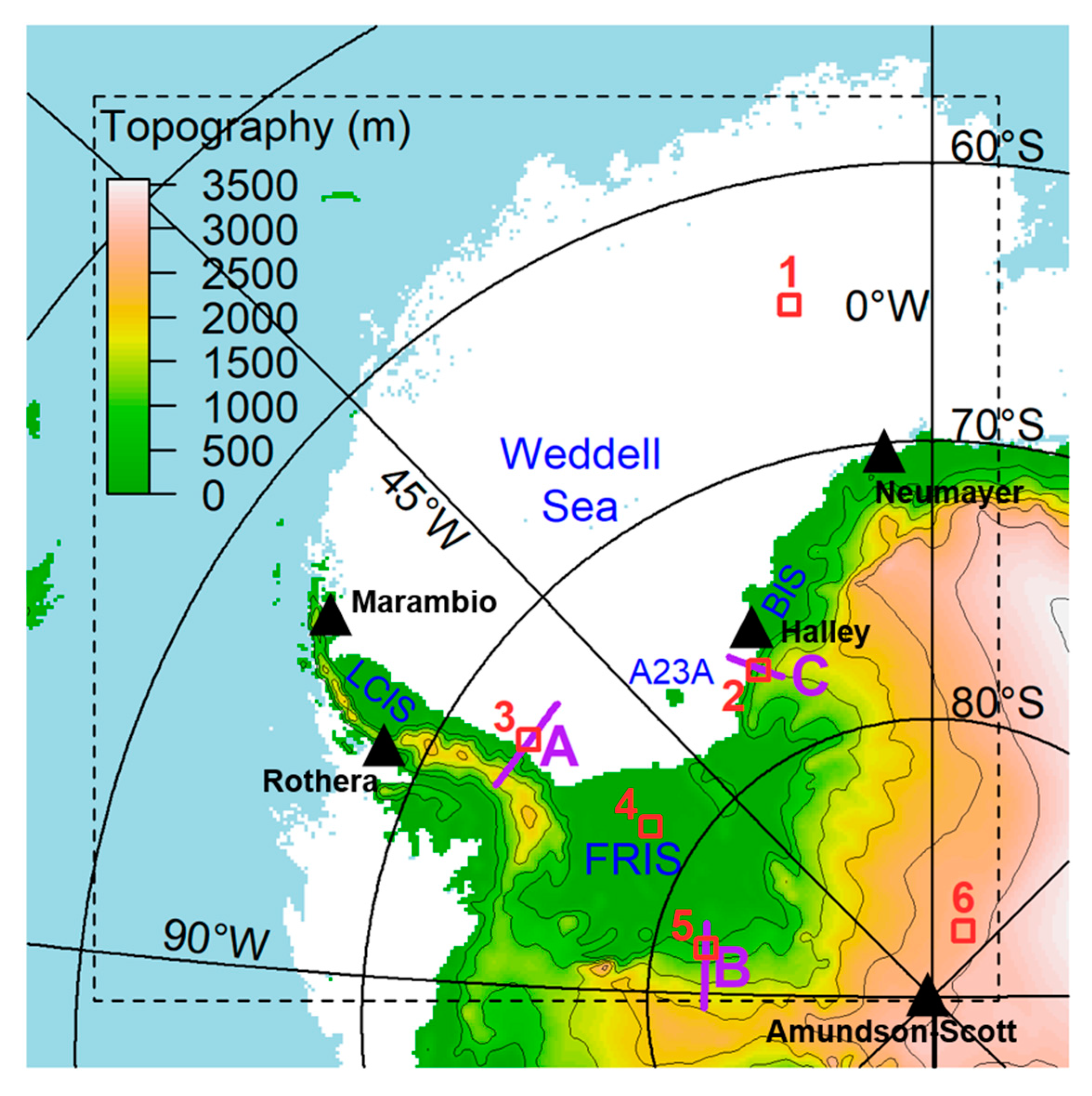
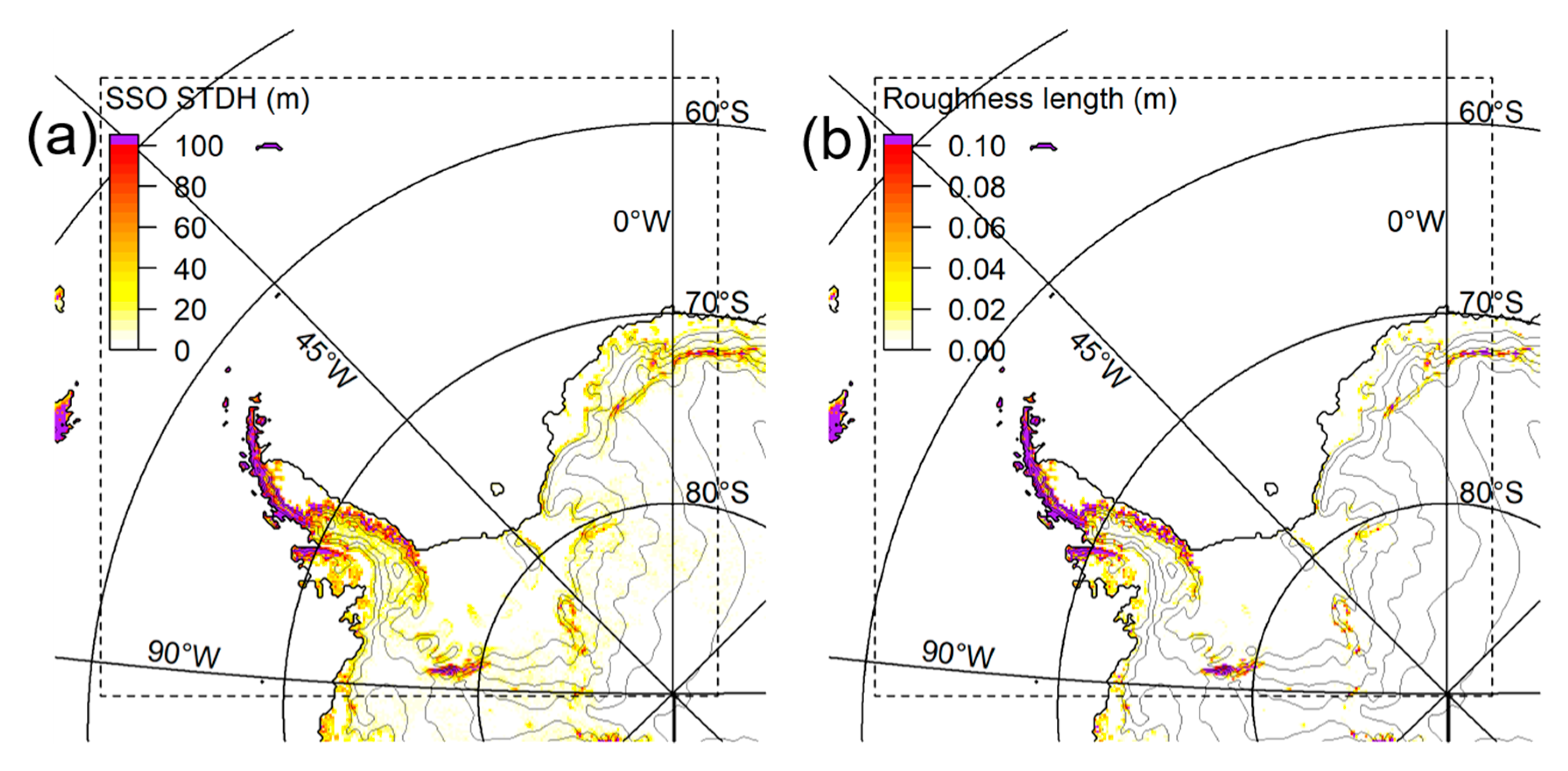


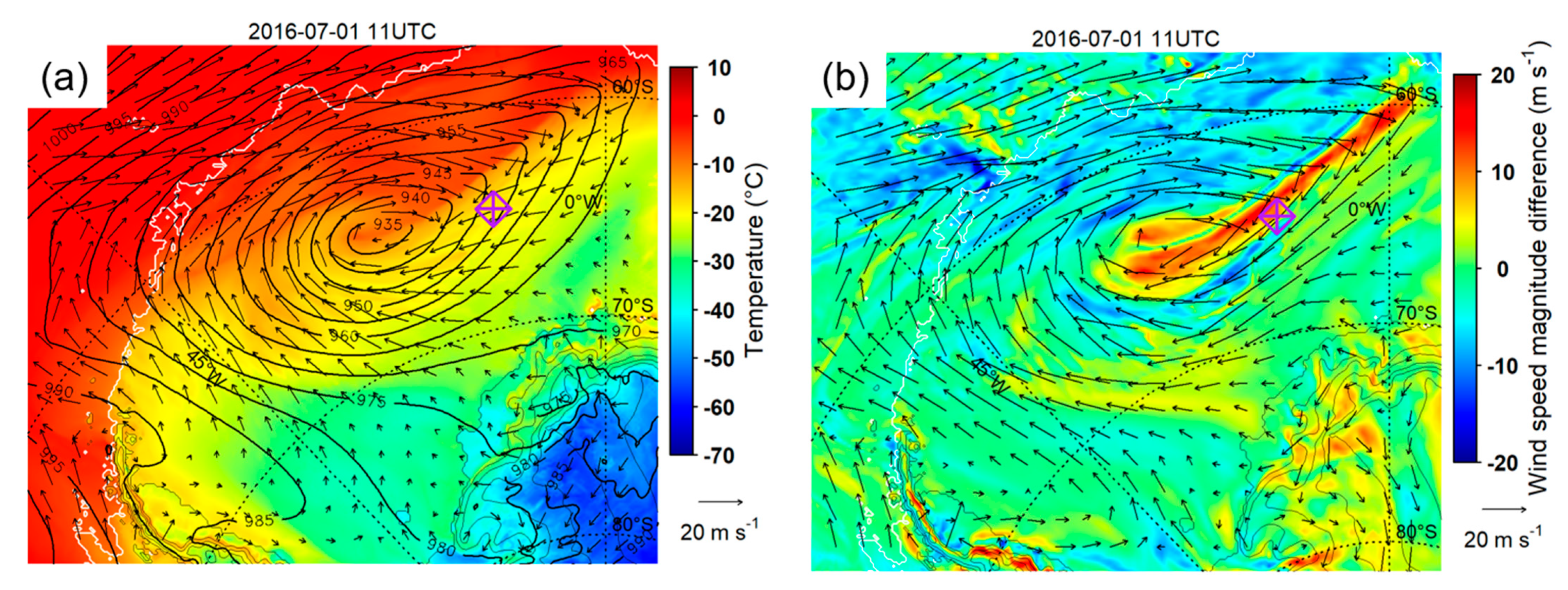
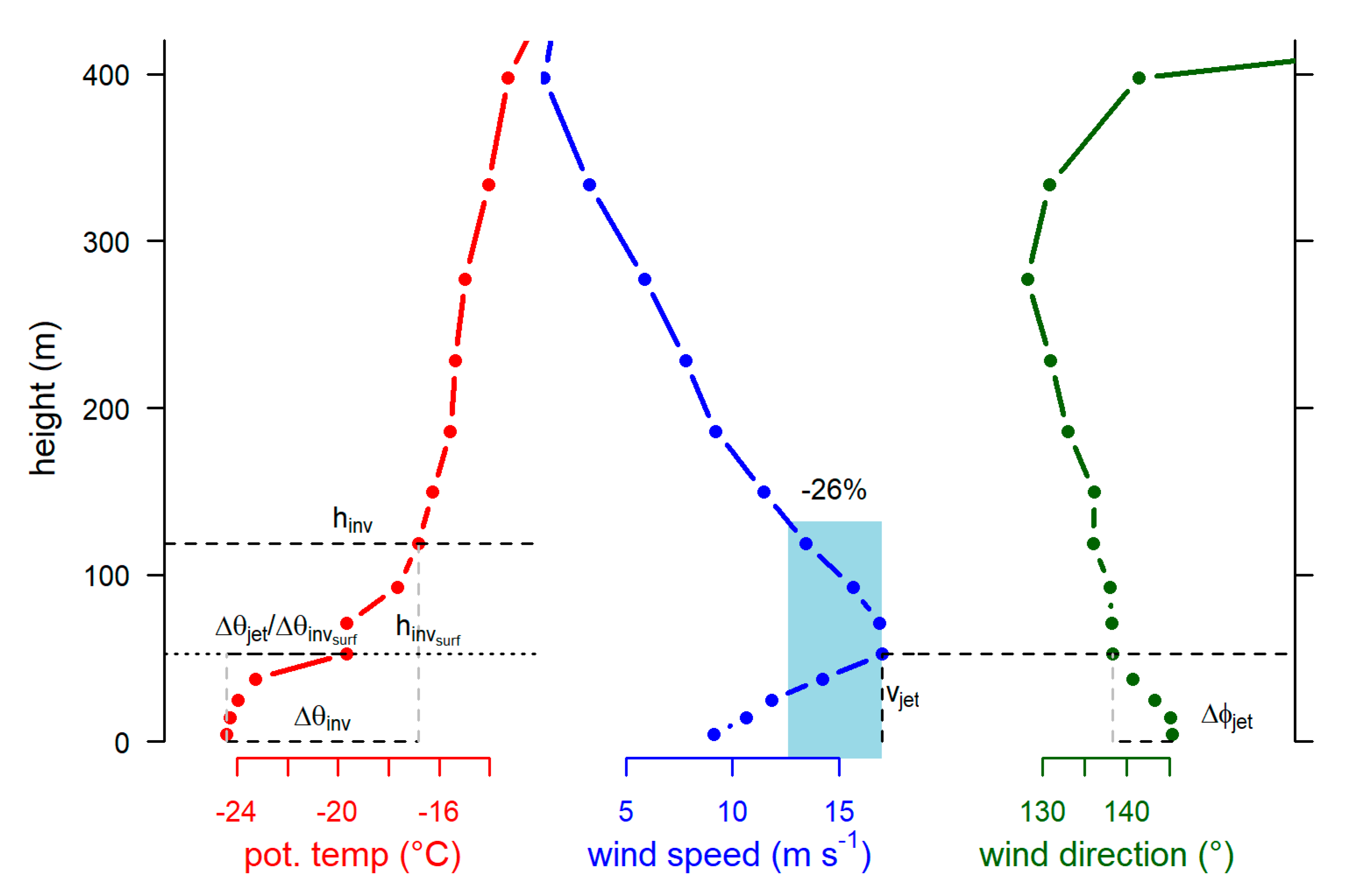
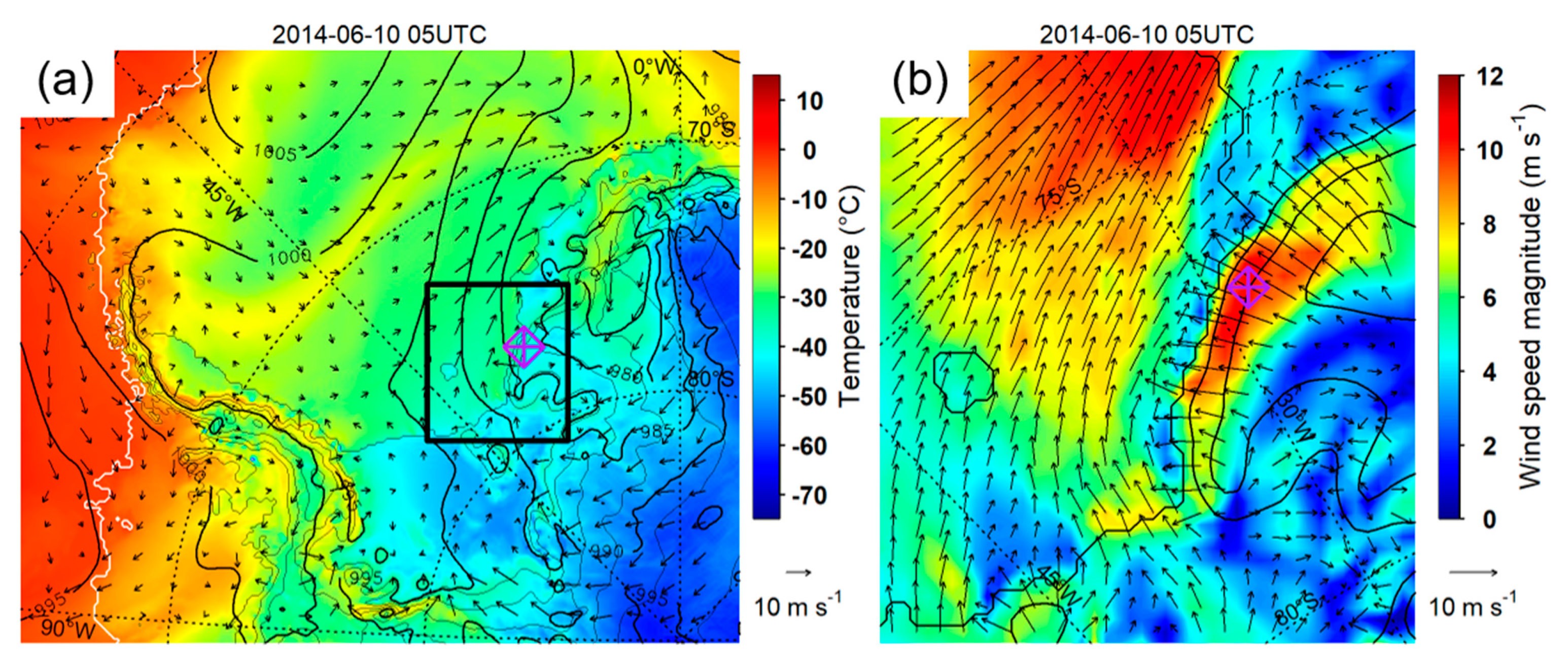

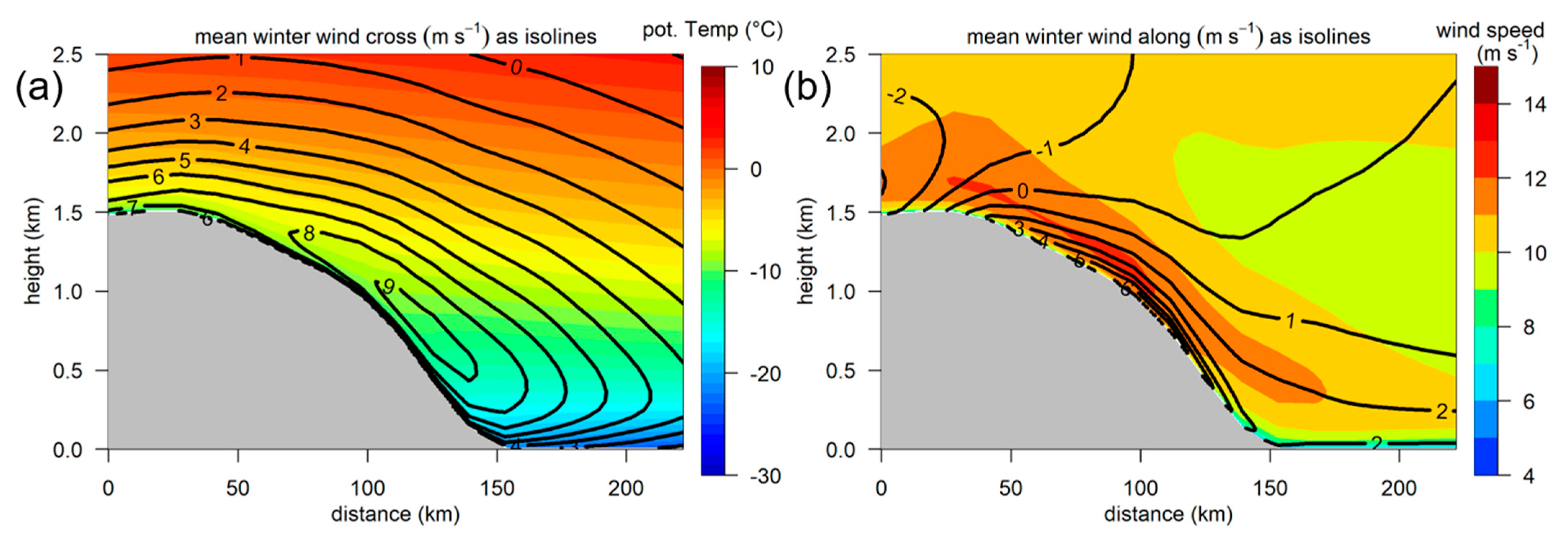
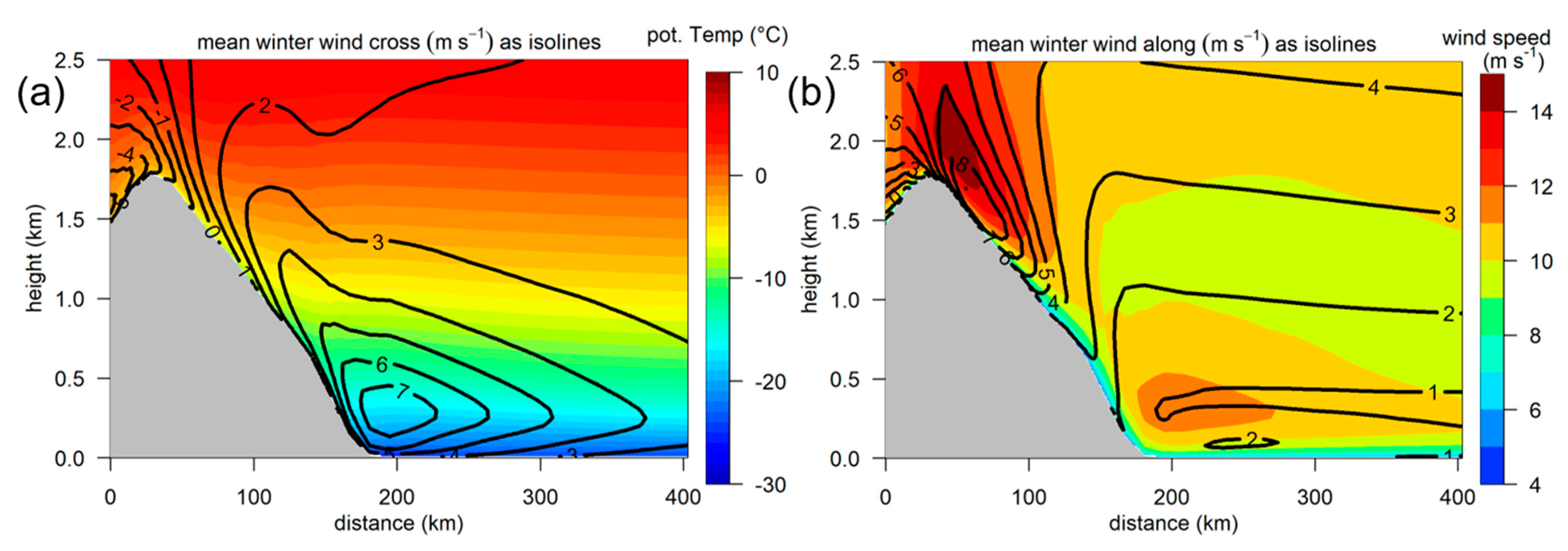


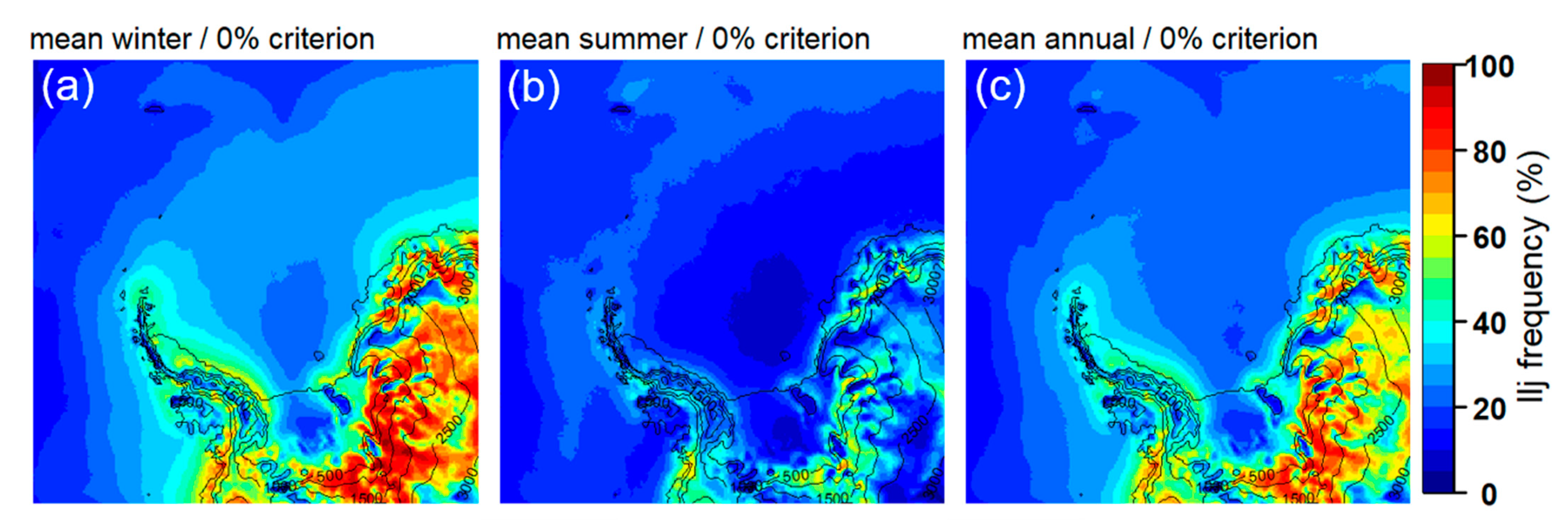



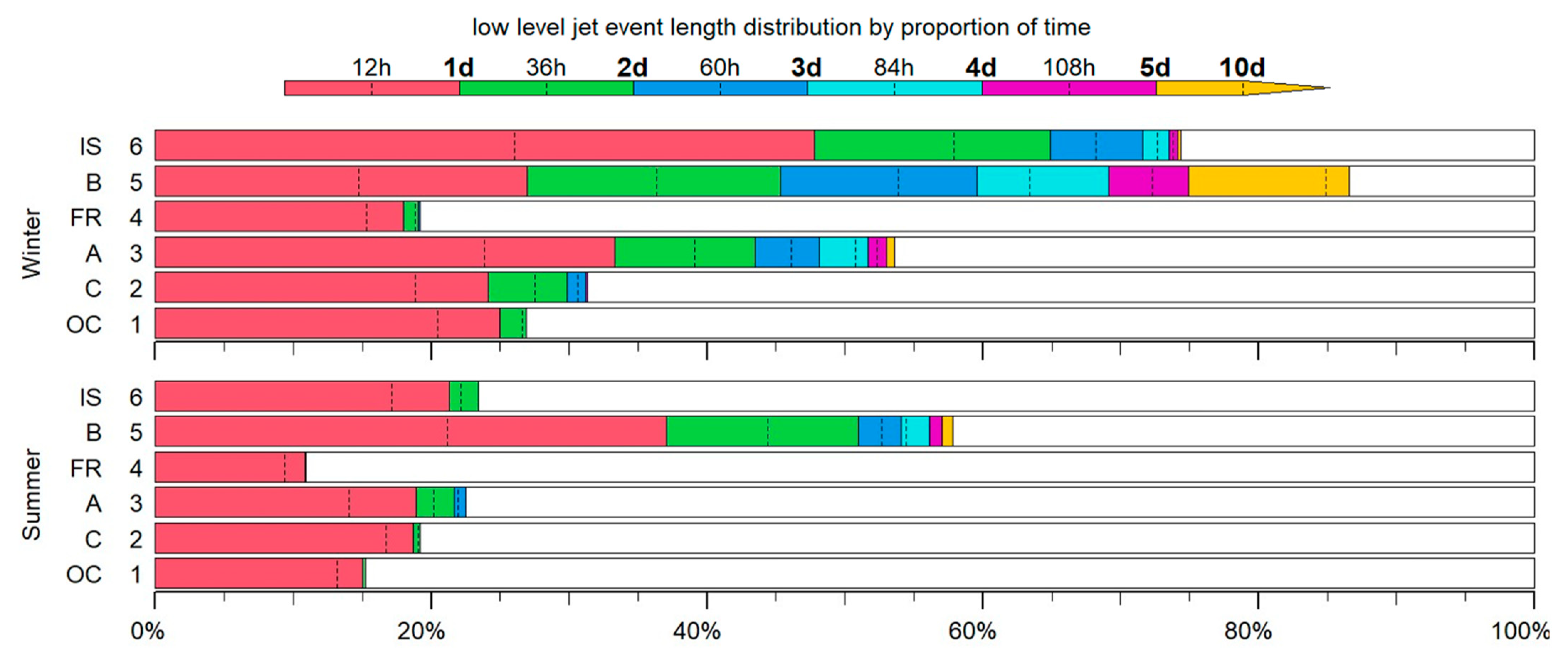

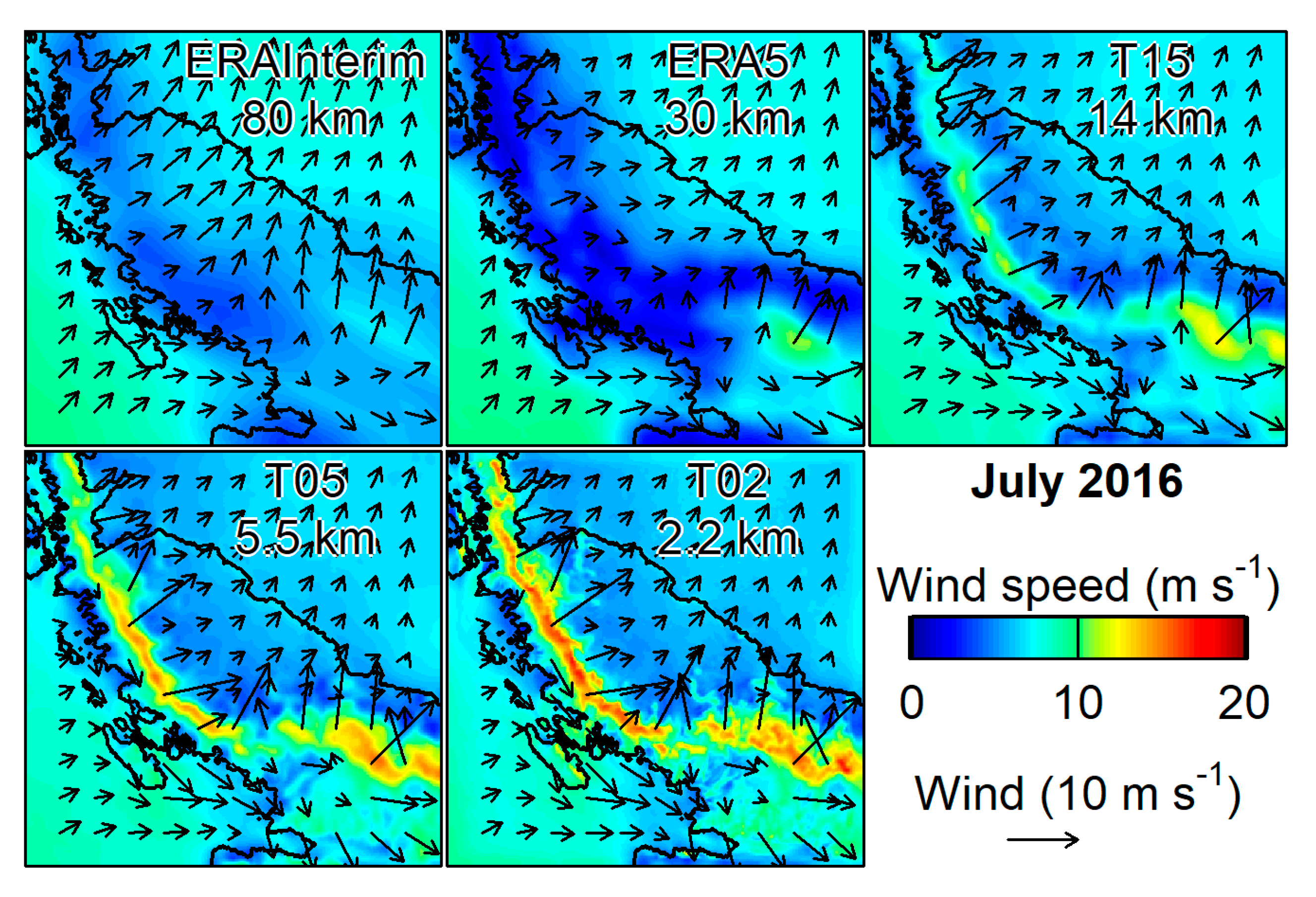
| Station | Profiles | Data Gaps | Remarks |
|---|---|---|---|
| Marambio | 1364 | 2007–2008 | Sparse data in 2002–2009 |
| Neumayer | 5355 | no | |
| Rothera | 1021 | 2008–2011 | No data for 8 to 11 months per year in 2002–2012 |
| Halley | 4877 | no | |
| Amundsen-Scott | 7664 | no | Vertical resolution in the lowest 500 m for 2002–2004 is too coarse to detect LLJs |
| Station | Frequency in % | Height in m | Speed in m/s | Rel. Speed Change in % | ||||
|---|---|---|---|---|---|---|---|---|
| RS | CCLM | Mean | Bias | Mean | Bias | Mean | Bias | |
| Marambio | 32 | 33 | 315 | −17 | 14.0 | 1.3 | 30 | −4 |
| Neumayer | 48 | 41 | 286 | −84 | 17.0 | −1.1 | 27 | 0 |
| Rothera | 30 | 37 | 531 | 53 | 18.0 | 6.9 | 30 | −12 |
| Halley | 46 | 39 | 291 | −50 | 14.3 | 0.9 | 30 | −5 |
| Amundsen-Scott | 14 | 55 | 102 | −150 | 12.9 | −0.3 | 33 | 7 |
Publisher’s Note: MDPI stays neutral with regard to jurisdictional claims in published maps and institutional affiliations. |
© 2021 by the authors. Licensee MDPI, Basel, Switzerland. This article is an open access article distributed under the terms and conditions of the Creative Commons Attribution (CC BY) license (https://creativecommons.org/licenses/by/4.0/).
Share and Cite
Heinemann, G.; Zentek, R. A Model-Based Climatology of Low-Level Jets in the Weddell Sea Region of the Antarctic. Atmosphere 2021, 12, 1635. https://doi.org/10.3390/atmos12121635
Heinemann G, Zentek R. A Model-Based Climatology of Low-Level Jets in the Weddell Sea Region of the Antarctic. Atmosphere. 2021; 12(12):1635. https://doi.org/10.3390/atmos12121635
Chicago/Turabian StyleHeinemann, Günther, and Rolf Zentek. 2021. "A Model-Based Climatology of Low-Level Jets in the Weddell Sea Region of the Antarctic" Atmosphere 12, no. 12: 1635. https://doi.org/10.3390/atmos12121635
APA StyleHeinemann, G., & Zentek, R. (2021). A Model-Based Climatology of Low-Level Jets in the Weddell Sea Region of the Antarctic. Atmosphere, 12(12), 1635. https://doi.org/10.3390/atmos12121635






